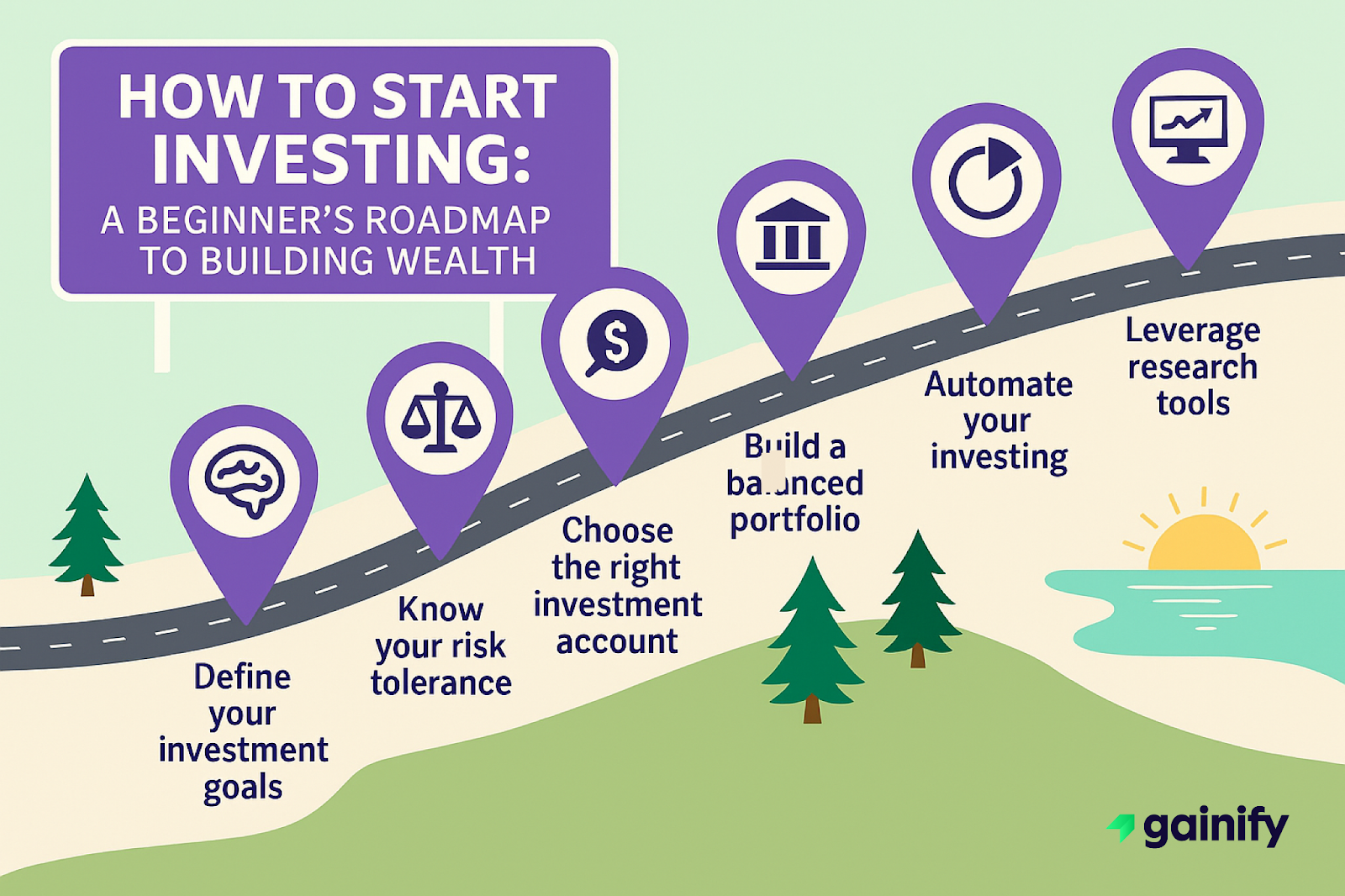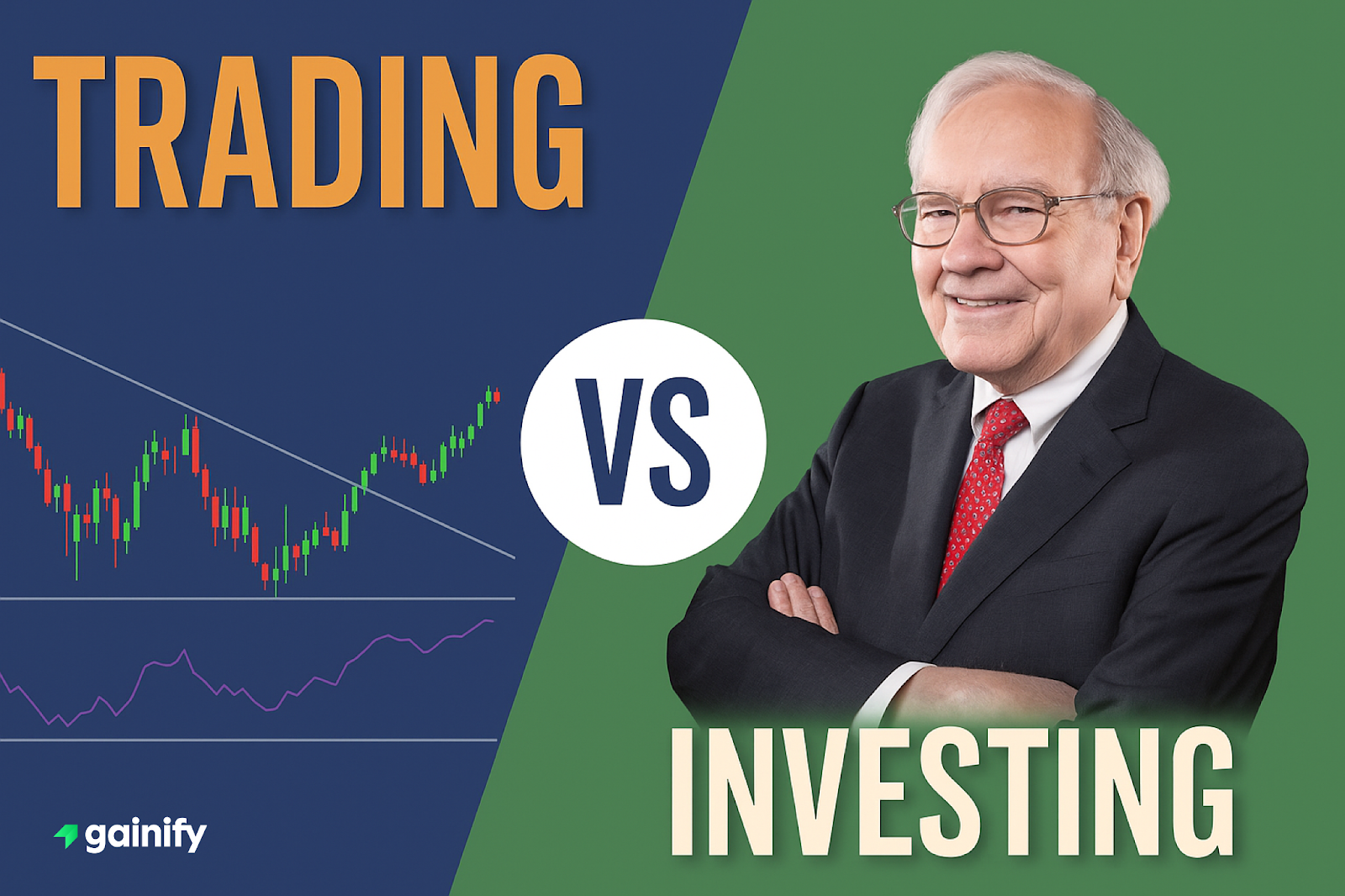Let’s be honest: investing sounds complicated.
For many, it feels like a game reserved for finance majors or stock market pros. With terms like “compound interest,” “dividends,” and “asset allocation” floating around, it’s easy to feel overwhelmed.
But here’s the good news: you don’t need a finance degree to get started.
The secret? Start small, start smart, and start now.
The biggest myth in investing is that you need a lot of money to begin. That couldn’t be further from the truth. Thanks to low-cost apps and commission-free platforms, you can start investing with just $5. And while stock-picking may sound exciting, the real winners are often those who invest consistently and stay patient.
In this article, we’ll walk you through how to start investing, step-by-step. We’ll cut through the noise, highlight smart strategies, and warn you about common traps. As a finance professional with years of experience, I’ll also share some contrarian insights that might surprise you. Spoiler alert: sometimes not investing is smarter than diving in unprepared.
By the time you’re done reading, you won’t just understand investing, but you’ll be ready to take action. Whether you’re planning for retirement plans, growing a diversified portfolio, or learning the basics of investing for educational purposes, this guide has you covered.
1. Define Your Investment Goals
Before anything else, ask yourself: “What am I investing for?” Common investment goals include saving for retirement, purchasing a home, funding a child’s education, building passive income through real estate, creating a rainy day fund, starting a business, or simply achieving financial independence. Clearly defining your goals will shape the entire structure of your investment plan from the types of accounts you open to the asset allocation you choose.
Each goal comes with a unique time horizon and level of acceptable investment risk. Understanding these helps you select the most suitable investment strategy.
- Short-term financial goals (under 3 years): These include saving for a vacation, emergency fund, or a wedding. Because the time frame is short, protecting your capital is more important than chasing high returns. Consider safer, liquid vehicles such as high-yield savings accounts, CDs, money market funds, or Treasury bills.
- Medium-term goals (3 to 10 years): Examples include saving for a down payment on a home, funding a child’s early education, or planning for a career change. Here, a mix of conservative and moderate investments like bond funds, balanced mutual funds, and ETFs with lower volatility can provide a reasonable balance of growth and safety.
- Long-term financial goals (10+ years): This is where investing shines. Whether you’re building a retirement nest egg, funding a child’s full college education, or generating long-term passive income through real estate, you can afford to take on more risk. Individual stocks, mutual funds, index funds, and real estate investment trusts (REITs) are all suitable for long-term growth.
By identifying a range of goals and matching them with appropriate types of investments, you can build a well-structured investment portfolio that supports your aspirations over time. This clarity not only improves financial planning but also helps in tracking your progress, adjusting allocations, and making more informed investment decisions.
2. Know Your Risk Tolerance
Every investor must come to terms with a fundamental truth: all financial instruments carry some form of investment risk. From inflation eating away at cash to market volatility impacting stocks, risk is always present. The key question is how much risk you can emotionally and financially handle.
Start by asking yourself how you would react if your portfolio dropped 10% or 20% in a short period. Would you stay the course, or would you be tempted to sell? Your honest answer helps determine your risk tolerance, which plays a crucial role in shaping your investment portfolio.
- If you’re someone who feels anxious during market downturns or values stability, you may be a risk-averse investor. A conservative allocation with a focus on bonds, high-quality large-cap stocks, asset allocation mutual funds, and dividend-paying ETFs might be more suitable.
- If you have a long time horizon and can weather market fluctuations, you may lean toward a moderate allocation or a moderately aggressive strategy for long-term investors. These approaches often include a balanced mix of stocks and bonds, offering both growth potential and some downside protection.
- If you’re comfortable with volatility and seek higher growth, an aggressive allocation for long-term investors may suit you. This typically includes a higher weighting in equities such as small-cap stocks, growth stocks, and even sector-specific ETFs. Over time, these strategies can deliver strong potential returns, but they also come with higher short-term swings.
It’s also important to consider your investment time frame, income stability, and financial goals. Younger investors often tolerate more risk because they have a longer period to recover from market downturns, while those nearing retirement might prioritize preservation over growth.
Consulting a financial professional, particularly a certified investment professional, can help clarify your profile. These experts can guide you through investment management options and craft a strategy that aligns with your goals.
There are also many online tools and sample asset allocation plans provided by reputable institutions such as Bank of America Corporation, HSBC Bank USA, or the Chief Investment Office. These resources offer data-driven models for aligning your goals, timeline, and temperament into a cohesive investment strategy.
3. Choose the Right Investment Account
You don’t invest directly in a stock. Instead, you invest through an account that acts as the gateway to various financial instruments. Choosing the right account is essential to maximize benefits and align with your goals.
- Roth IRA or Traditional IRA: These are ideal for individual retirement savings. A Roth IRA allows for tax-free withdrawals in retirement, while a Traditional IRA may offer income tax deductible contributions. Both provide opportunities for tax-deferred growth over time.
- 401(k): Often provided by employers, this account includes potential matching contributions and typically comes with a clear fee schedule. It’s a popular option for building long-term wealth through regular payroll deductions.
- Brokerage account: This type of account is highly flexible. It provides access to a wider range of investment solutions, including option trades, online equity trades, mutual funds, and individual stocks like small-cap stocks. While not tax-advantaged, it allows for more control and liquidity.
When selecting an account, always consider your initial investment requirement and any subsequent contributions you’ll need to make. It’s also wise to consult a tax advisor to understand how different accounts and investments align with your financial plan and tax situation.
4. Build a Simple, Balanced Investment Portfolio
Before choosing specific investments, it is essential to decide on an appropriate asset allocation. This means determining how to divide your money among different asset classes such as stocks, bonds, and cash equivalents. This decision is one of the most important factors influencing your portfolio’s long-term performance and risk level.
A balanced portfolio typically includes a mix of equity investments (for growth), bond ETFs or other fixed-income instruments (for income and stability), and money market funds or cash (for liquidity and short-term needs). The exact mix should reflect your risk tolerance, time horizon, and financial goals.
Most beginners benefit from a diversified bundle of investments like index funds or exchange-traded funds (ETFs). These reflect broad asset classes such as the S&P 500 or total market indices. They help reduce the risk of relying on individual stocks. Platforms like Vanguard ETF Shares, iShares by BlackRock, and Merrill Guided Investing with Advisor Program offer low-cost, transparent options that are ideal for long-term investors.
Some investors also include individual blue-chip stocks. These are established companies with stable earnings and consistent dividends. While they are slightly riskier because they represent a single company, they can offer quality exposure and are often more resilient during downturns.
Here are two straightforward allocation examples:
- Conservative Allocation: 40% bond ETFs or fixed income, 30% broad-market ETFs (e.g., S&P 500), 20% cash or money market funds, 10% blue-chip stocks.
- Growth Allocation: 40% broad-market ETFs (e.g., total market or S&P 500), 35% individual equities including blue-chip and growth stocks, 15% bond ETFs or fixed income, 10% cash or money market funds.
These strategies aim to balance risk and reward while following proven investment approaches. The conservative model prioritizes capital preservation and stability. The growth model focuses on long-term equity appreciation while still maintaining some fixed income and liquidity.
Whether you want steady growth or simplicity, relying on diversified, low-cost investments is often more effective than trying to chase market trends. It is better to stay consistent and maintain a long-term perspective.
5. Automate Your Investing and Be Consistent
Success in investing often depends more on discipline than on market expertise. One of the best habits you can build is to automate your monthly contributions to your investing accounts. This ensures that you continue to invest regularly, regardless of market conditions.
By using dollar-cost averaging, you invest a fixed amount at regular intervals. Over time, this strategy can help reduce the impact of market volatility and prevent emotional decision-making that often leads to buying high and selling low.
Many modern investing platforms allow you to set up automatic deposits and recurring investments. These tools make it easier to stick with your investing plan, especially for individuals who prefer a hands-off approach or are just beginning their investment journey.
Automation also helps build consistency, which is critical for compounding returns over the long term. Whether you are conservative or growth-focused, staying committed to a regular investing routine is one of the most effective ways to grow your portfolio.
6. Leverage Equity Research Tools Like Gainify
If you’re interested in maximizing long-term upside, especially through individual stocks, equity research tools can offer a significant advantage. Platforms like Gainify provide access to detailed financial data, earnings trends, valuation metrics, and sector comparisons that help uncover strong investment opportunities.
These tools are particularly valuable when trying to identify high-quality businesses with durable competitive advantages, strong balance sheets, and potential for future growth. For example, you can use Gainify to filter for undervalued stocks, analyze management performance, or compare historical and projected returns across industries.
While individual stocks carry more risk than diversified ETFs or mutual funds, they also offer the potential for outsized gains. Equity research platforms give you the context and analysis needed to make more confident, well-informed decisions.
Gainify also allows you to evaluate how a stock might fit within your overall portfolio, helping you manage concentration risk and align each investment with your broader objectives. Although tools like these are for informational purposes and not a substitute for professional guidance, they are extremely helpful for self-directed investors who want to take a more active role in their strategy.
As you build experience, incorporating research into your process helps transform speculation into strategy. If you’re looking for meaningful upside and are ready to invest the time to research thoroughly, individual equities supported by the right tools can be a rewarding path.
7. Monitor and Adjust Regularly
Investing is not a one-time decision. After you begin, it is important to monitor your portfolio regularly and make adjustments as your life and the market evolve. Review your portfolio at least once or twice a year to ensure it still aligns with your goals, time horizon, and risk tolerance.
Key areas to check include whether your asset allocation has drifted, if your risk profile has changed, or if certain investments are no longer suitable. Rebalancing may be necessary to bring your portfolio back to its intended proportions. For example, if stocks perform well and grow to make up a larger share of your holdings than intended, you might consider shifting some gains into bonds or other asset classes.
Major life changes such as a new job, marriage, or having children should also trigger a review of your investment plan. The more intentional you are about staying aligned with your goals, the more effective your investment strategy will be over time.
Staying informed, tracking your progress, and making timely adjustments can help you stay on course even in uncertain markets. Consistent monitoring reinforces your commitment and keeps your long-term strategy intact.
Contrarian View: When Not to Invest
Investing consistently over time is a sound principle, but there are situations where it is better to wait. If you carry high-interest debt, such as credit card balances with annual interest rates above 15%, your priority should be to pay that off first. The guaranteed return from reducing that debt is often higher than the average return you might expect from the stock market.
Another reason to delay investing is the absence of an emergency fund. A solid financial foundation includes three to six months of essential living expenses saved in a high-yield savings account or money market fund. This buffer protects you from having to liquidate investments in a downturn if an unexpected expense occurs.
Before committing to the market, assess your basic financial stability. Are your bills paid on time? Is your income consistent? Do you have insurance coverage for health, auto, and life? These essentials must be in place to reduce financial stress and avoid forced investment decisions.
During this time, focus on building financial literacy. Learn about investment accounts, types of investments, tax implications, and budgeting. Research brokerages, compare fees, and understand how Social Security and other benefits may affect your long-term plans.
Once your finances are more stable, you can begin investing with greater confidence. Starting from a strong position allows you to stay invested longer, take appropriate risks, and avoid decisions driven by short-term financial pressure. Investing works best when your foundation is solid.
Final Thoughts: Start Where You Are
Successful investing is not about finding the perfect time or strategy. It is about taking consistent action based on your goals, risk tolerance, and financial situation. Whether you use a robo-advisor, manage a diversified portfolio on your own, or work with a financial professional, the key is to stay focused and make steady progress.
Even modest contributions, made regularly and invested wisely, can grow significantly over time. The power of compounding becomes most effective when paired with patience and a long-term mindset. Align your investment approach with your values, revisit your strategy as life changes, and seek guidance when needed.
Start with what you have and build gradually. The most important step is the first one. It should be taken with clarity, purpose, and confidence.
FAQs: How to Start Investing
Q: How much money do I need to start investing?
A: Many investment companies allow you to start with as little as $5. Always review the investment minimum and check the Fee Schedule.
Q: What should I invest in as a beginner?
A: Start with a diversified portfolio of ETFs, mutual funds, or blue chip stocks that spread risk across asset classes and types of investments.
Q: Is it better to pay off debt or invest?
A: If your debt has high interest (well above 8%), paying it off may yield a better return than the potential returns of the market.
Q: Should I invest during a recession or market crash?
A: Yes, if you have a safety net. Crashes can offer access to undervalued online stock and increase future investment returns.
Q: What’s the biggest mistake beginners make?
A: Focusing on hype rather than fundamentals. Use platforms that offer expert insights and always do your research before buying into individual stocks.




